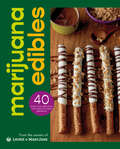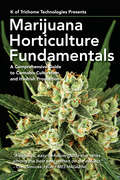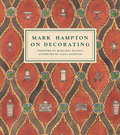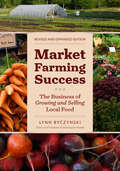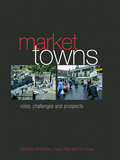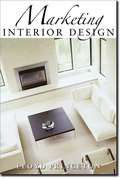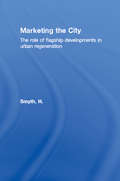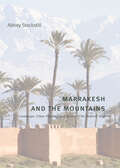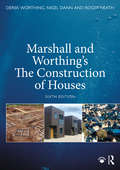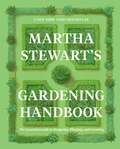- Table View
- List View
Marijuana Edibles: 40 Easy & Delicious Cannabis Confections
by Laurie Wolf Mary ThigpenMake your own marijuana-based desserts, candies, and sweet-and-salty treats! Eating or ingesting marijuana rather than inhaling it gives a longer, more-powerful high, spares your lungs, and allows you to partake in private. This makes it perfect for patients who need steady relief from pain, or for those who just want to add marijuana to food for enjoyment. Marijuana Edibles demystifies the edibles cooking process, covering the most popular extraction methods and helping you make your own delicious cannabis-infused edibles at home. Here&’s what you&’ll find in this fun and fascinating cookbook: · Recipes for 40 different perfectly-dosed, delicious treats—each featuring beautiful photography · Recipes ranging from cookies and bars, to chocolates, truffles, cakes, and frozen treats, including several vegan and gluten-free options · Tips on the equipment you&’ll need to make your infusions, with detailed guidance on how to decarb your cannabis and how to calibrate your infusions · Instructions for cooking with infusions and for making simple, single-serving edibles for quick ingestion
Marijuana Edibles: 40 Easy and Delicious Cannabis-Infused Desserts
by Laurie Wolf Mary ThigpenMake your own marijuana-based desserts, candies, and sweet-and-salty treats! Eating or ingesting marijuana rather than inhaling it gives a longer, more-powerful high, spares your lungs, and allows you to partake in private. This makes it perfect for patients who need steady relief from pain, or for those who just want to add marijuana to food for enjoyment. Marijuana Edibles demystifies the edibles cooking process, covering the most popular extraction methods and helping you make your own delicious cannabis-infused edibles at home. Here&’s what you&’ll find in this fun and fascinating cookbook: · Recipes for 40 different perfectly-dosed, delicious treats—each featuring beautiful photography · Recipes ranging from cookies and bars, to chocolates, truffles, cakes, and frozen treats, including several vegan and gluten-free options · Tips on the equipment you&’ll need to make your infusions, with detailed guidance on how to decarb your cannabis and how to calibrate your infusions · Instructions for cooking with infusions and for making simple, single-serving edibles for quick ingestion
Marijuana Garden Saver
by Ed Rosenthal J. C. StitchUtilizing a handy, field-guide style, this book is divided into five sections by problem type: Pests, Diseases, Environmental Stresses, Nutrient Deficiencies, and Controls. Problems are alphabetized within each section and identified in full-color photographs. A quick overview of the problem and likely causes is followed by the author's recommended fast and easy solution.
Marijuana Garden Saver: Handbook for Healthy Plants
by Ed Rosenthal J. C. StitchUtilizing a handy, field-guide style, this book is divided into five sections by problem type: Pests, Diseases, Environmental Stresses, Nutrient Deficiencies, and Controls. Problems are alphabetized within each section and identified in full-color photographs. A quick overview of the problem and likely causes is followed by the author's recommended fast and easy solution.
Marijuana Grower's Handbook
by Tommy Chong Ed RosenthalThe all new Marijuana Grower's Handbook shows both beginners and advanced growers how to grow the biggest most resinous, potent buds! This book contains the latest knowledge, tools, and methods to grow great marijuana - both indoors and outdoors. Marijuana Grower's Handbook will show you how to use the most efficient technology and save time, labor, and energy. Ed Rosenthal is the world's foremost expert on marijuana cultivation and this is the official course book at Oaksterdam University, the leading cannabis trade school. With 500 pages of full color photos and illustrations, the book delivers all the basics that a novice grower needs, as well as scientific research for the experienced gardener. All aspects of cultivation are covered, from the selection of varieties, setting up of the garden, and through each stage of plant growth all the way to harvesting. Full color photographs throughout clarify instructions and show the stunning results possible with Ed's growing tips."Marijuana may not be addictive, but growing it is." - Ed Rosenthal
Marijuana Grower's Handbook
by Tommy Chong Ed RosenthalThe all new Marijuana Grower's Handbook shows both beginners and advanced growers how to grow the biggest most resinous, potent buds! This book contains the latest knowledge, tools, and methods to grow great marijuana - both indoors and outdoors. Marijuana Grower's Handbook will show you how to use the most efficient technology and save time, labor, and energy. Ed Rosenthal is the world's foremost expert on marijuana cultivation and this is the official course book at Oaksterdam University, the leading cannabis trade school. With 500 pages of full color photos and illustrations, the book delivers all the basics that a novice grower needs, as well as scientific research for the experienced gardener. All aspects of cultivation are covered, from the selection of varieties, setting up of the garden, and through each stage of plant growth all the way to harvesting. Full color photographs throughout clarify instructions and show the stunning results possible with Ed's growing tips."Marijuana may not be addictive, but growing it is." - Ed Rosenthal
Marijuana Horticulture Fundamentals: A Comprehensive Guide to Cannabis Cultivation and Hashish Production
by K of Trichome TechnologiesThe first and only grow book from Trichome Technologies' legendary breeder, K, this is a must-have for every grower on the planet, from rookie cupboard growers to commercial cultivators. <P><P>Walking you through every single stage of growing, from learning about the plant itself to extracting your expertly grown trichomes into stellar-quality hash, K shares unknown tricks and tips from his 20-year career. Whether you're just starting out and want to know the best medium to use, or you've been growing all your life and want to optimize your set-up, this book tells you everything you want to know and more.
Marijuana Outdoor Grower's Guide
by S. T. OnerMarijuana Outdoor Grower's Guide is written for first-time growers who are looking to learn the basics and have a successful personal crop. For the more experienced grower, the book includes advice on how to enhance the productivity of your plants and ensure success with every attempt. With focus on creating a small grow area that will produce without problems, this book will be an invaluable resource for those with little familiarity with the process of raising marijuana plants.Starting from a brief overview of marijuana itself and the issues surrounding it, S.T. Oner discusses the pros and cons of growing outdoors, and how best to utilize the tools at your disposal, such as household waste. Through selecting seeds and choosing a grow spot to maximizing security and actually raising your plants, he writes in a manner that is easy to follow and helpfully instructive at the same time. Protection from pests as well as the elements, how best to harvest and how the more advanced grower can move forward in their career are all covered, as are the basics are cooking with your harvested bud.
Marijuana Pest and Disease Control
by Ed Rosenthal Kathy ImbrianiA wide range of pests, diseases, and nutrient deficiencies can zap the vitality of any cannabis garden. Inexperienced gardeners often rely on pesticides that are not registered for edibles, as well as other harmful or ineffective techniques that can render plants unusable. This resourceful guide comes to the rescue, showing gardeners how to win back a garden and nurture plants to their full potential, using safe, organic, and integrated pest management techniques. In addition to providing readers with the know-how to get their plants healthy, Marijuana Pest and Disease Control highlights design and garden practices to prevent future infections. Author Ed Rosenthal gears the book to gardeners at every level of experience and in any growing situation from indoor, outdoor, and greenhouse to hydro and terrace gardens. Extensive color photographs and illustration help identify the exact problem.
Marijuana Pest and Disease Control
by Ed Rosenthal Kathy ImbrianiA wide range of pests, diseases, and nutrient deficiencies can zap the vitality of any cannabis garden. Inexperienced gardeners often rely on pesticides that are not registered for edibles, as well as other harmful or ineffective techniques that can render plants unusable. This resourceful guide comes to the rescue, showing gardeners how to win back a garden and nurture plants to their full potential, using safe, organic, and integrated pest management techniques. In addition to providing readers with the know-how to get their plants healthy, Marijuana Pest and Disease Control highlights design and garden practices to prevent future infections. Author Ed Rosenthal gears the book to gardeners at every level of experience and in any growing situation from indoor, outdoor, and greenhouse to hydro and terrace gardens. Extensive color photographs and illustration help identify the exact problem.
Marijuana Pest and Disease Control: How to Protect Your Plants and Win Back Your Garden
by Ed Rosenthal Kathy ImbrianiA wide range of pests, diseases, and nutrient deficiencies can zap the vitality of any cannabis garden. Inexperienced gardeners often rely on pesticides that are not registered for edibles, as well as other harmful or ineffective techniques that can render plants unusable. This resourceful guide comes to the rescue, showing gardeners how to win back a garden and nurture plants to their full potential, using safe, organic, and integrated pest management techniques. In addition to providing readers with the know-how to get their plants healthy, Marijuana Pest and Disease Control highlights design and garden practices to prevent future infections. Author Ed Rosenthal gears the book to gardeners at every level of experience and in any growing situation from indoor, outdoor, and greenhouse to hydro and terrace gardens. Extensive color photographs and illustration help identify the exact problem.
Marijuana Smoker's Guidebook
by Matt MernaghMatt Mernagh's Marijuana Smoker's Guidebook is the ultimate field guide for marijuana. Featuring 180 commercially-available cannabis strains from across the world, this book shows and tells you how to identify and enjoy the buds you've got, the buds you want and the buds you might never even have heard of.Though there are a great many strain guides currently available, they all feature rare and difficult to find strains, and show how each different plant looks as it grows. This is great for cannabis connoisseurs and breeding professionals, but what about the everyday street smoker who just needs to identify and know about the buds he's buying?Written and photographed with this inquisitive everyday smoker in mind, Marijuana Smoker's Guidebook features 180 descriptions and smoke reports of North America's most popular marijuana strains as well as high resolution photos of each bud to show you exactly what your nugs should look like. Unlike some strain guides which use glorified catalog copy as strain descriptions, every single strain in this book has been smoked by Matt Mernagh himself, with an informative, original and entertaining write up and high resolution photo to bring you up to speed on your weed.Pocket-sized and featuring photos and descriptions of strains from Barney's Farm's LSD to the elusive Jean Guy, and many more for all your favorite smokes, Marijuana Smoker's Guidebook is the indispensible resource for everyone who loves pot and wants to learn more about how to identify and enjoy good marijuana.
Marijuana Success Indoors
by Ed RosenthalMarijuana Success Indoors looks into the gardens of real people to see how they have combined gardening skill with technological savvy to produce quality buds. This large-format, 8.5 x 11 inch book focuses on homegrowing cultivation issues and solutions, including working in small spaces, the use of hydroponics versus planting mix gardens, lighting, and supplementing with CO2. A great companion to information found in grow guides Marijuana Success Indoors shows what types of problems are encountered in actual gardening situations, and how they are addressed to result in success.
Marijuana Success Indoors: Garden Tours and Tips
by Ed RosenthalMarijuana Success Indoors looks into the gardens of real people to see how they have combined gardening skill with technological savvy to produce quality buds. This large-format, 8.5 x 11 inch book focuses on homegrowing cultivation issues and solutions, including working in small spaces, the use of hydroponics versus planting mix gardens, lighting, and supplementing with CO2. A great companion to information found in grow guides Marijuana Success Indoors shows what types of problems are encountered in actual gardening situations, and how they are addressed to result in success.
Marijuana for Everybody!: The Definitive Guide to Getting High, Feeling Good, and Having Fun
by Elise McDonough High Times“A surprisingly deep guide to pot culture . . . 192 pages of legit knowledge” from the author of The Official High Times Cannabis Cookbook (The Cannabist).Marijuana is more widely available and accepted than ever before, with more people coming to the plant every day for a range of reasons. From the experts at High Times magazine—the world’s most trusted name when it comes to getting stoned—here is an authoritative, accessible guide to marijuana, its uses, and culture. This illustrated handbook offers clear and friendly primers on subjects such as what pot is and how it works, tips on getting high and managing the experience, cooking with pot, and FAQs as well as an “I’m High, Now What?” selection of activities and amusements for the freshly baked. Part manifesto, part party invitation, Marijuana for Everybody! is an informative and entertaining read for the uninitiated and practiced users alike.“The rapidly advancing world of weed gets broken down into easy chunks on topics like ‘cannabis chemistry,’ ‘how to: roll the classic cone,’ and ‘where do bongs come from?’ . . . The list-lovers will dig: 8 items to look for on the label when you buy legal weed; 6 things to do if you think you’re too high; 7 things to keep in mind when buying edibles; and 10 common marijuana strains and their characteristics.” —Smell the Truth“Well-written, carefully researched and incredibly thorough . . . If you have even a passing interest in marijuana, start clearing a space between your grinder and bong for this book on your coffee table.” —Willamette Week
Marijuana: Let's Grow a Pound
by SeemorebudsWant to grow more marijuana than you can smoke? Let's Grow a Pound is an easy to follow day-by-day guide that will help you grow a bigger harvest than you ever imagined possible.SeeMoreBuds, author of the hit Marijuana Buds For Less, has taken all the guesswork out of growing indoors and harvesting more than a pound of marijuana in under three months. Each of the 73 days it takes to get to a bountiful harvest is described and demonstrated with beautiful full-color photographs. The equipment needed, set up, and each stage of growing, care taking, hydrating, feeding and identifying and dealing with potential problems are all here.This book is a must-have for anyone even interested in growing the finest marijuana around without spending an arm and a leg. The methods demonstrated in the book are guaranteed to lead a grower to success, whether they are a complete novice or an experienced "greenthumb" looking for a better way to grow.Let's Grow A Pound is published and edited by world-famous marijuana cultivator Ed Rosenthal.
Marijuana: guida per principianti sulla coltivazione della marijuana
by Nancy Ross Marilena Martucci"Marijuana: guida per principianti sulla coltivazione della marijuana"è una quida valida, snella e molto precisa che accompagnerà il coltivatore inesperto a compiere i suoi primi passi verso la coltivazione della cannabis. Ogni argomento viene spiegato con linearità e nulla viene lasciato al caso. Una lettura affascinante anche solo per entrare in contatto con la coltivazione di una pianta che viene da molti considerato un tabù, ma che porta grandi benefici.
Mark Hampton On Decorating
by Alexa Hampton Mark Hampton Margaret RussellWhen On Decorating was published in 1989, it immediately became a touchstone for design profesionals and enthusiasts. Since then, the ideas and illustrations within these pages have inspired countless room schemes, vignettes, and color palettes. Mark Hampton's expert insights into the creation of elegant rooms, and his remarkably immediate voice, remain just as relevant today.Posthumously celebrated by Architectural Digest as "one of the wold's twenty greatest designers of all time," Hampton regarded every design project as a collaboration. That same generosity of spirit pervades this book, offering signature principles that can easily be applied to any home. In the Colors section, Hampton makes a convincing case fo using dark green as a neutral, and encourages readers not to fear painting walls red. In Plans, he explains the keys to arranging a living room that telegraphs comfort, not just refinement. In Materials, Hampton demonstrates how strongly patterned wallpaper can visually enlarge a small space, contrary to popular belief.Throughout this colleciton of essays, which were substantially expanded from his popular House & Garden columns, Hampton shares witty anecdotes and observations that render this education in home decoration a delight. Faithfully reproduced with his original, often-emulated watercolor illustrations and with an afterword by his duaghter, reowned designer Alexa Hampton, this beautiful reprint edition is a book to pore over, savor, and share.
Market Farming Success: The Business of Growing and Selling Local Food, 2nd Editon
by Lynn ByczynskiAn insider's guide to market gardening and farming for those in the business of growing and selling food, flowers, herbs, or plants.Market Farming Success identifies the key areas that usually trip up beginners—and shows how to avoid those obstacles. This book will help the aspiring or beginning farmer advance quickly and confidently through the inevitable learning curve of starting a new business.Written by the editor of Growing for Market, a respected trade journal for market farmers, Market Farming Success condenses decades of growing experience from every part of the United States and Canada. It focuses on the factors that are common to market gardeners everywhere and offers professional advice that includes:• How much you'll need to spend to start a market farming business;• How much you can expect to earn;• Which crops bring in the most money—and whether you should grow them;• The essential tools and equipment you will need;• The best places to sell your products;• How to keep records to maximize profits and minimize taxes;• Tricks of the trade that will make you more efficient in the greenhouse, field, and market.This new Chelsea Green edition of a 2006 classic is greatly updated and expanded, and includes full-color photos, charts, and graphs, plus many inspiring and instructive profiles of successful market-farming pioneers.
Market Towns: Roles, challenges and prospects
by Neil PoweOriginal and insightful, this volume, giving in-depth consideration to the key issues affecting the future of market towns, provides readers with a framework for evaluating policy initiatives and progress in market towns.Through a detailed analysis of the characteristics of over 200 towns and in-depth studies of eleven towns in different parts of E
Marketing Interior Design
by Lloyd PrincetonWhy struggle to market interior design when you can get specialized advice from a top-notch consultant? In Marketing Interior Design, Lloyd Princeton offers you the same high-quality insights that he gives to his clientele. Drawing on his professional expertise as well as the experiences of his clients, he provides detailed guidance to help you learn to: figure out what to charge and have the confidence to demand that price write your business statement brand your business, including designing promotional materials find leads and take advantage of them through networking land jobs and learn how to handle the interview process protect yourself with contracts take advantage of the burgeoning market for green products and services. This insider guide is packed with examples of good (and bad) marketing materials, first-hand stories, and sample contract forms. If you are starting out in the field of interior design, or just want to retool your existing business, you need Marketing Interior Design!
Marketing the City: The role of flagship developments in urban regeneration
by H. SmythThis book assesses the value of flagship developments and draws out lessons for best policy and practice. It looks at marketing strategies and the sales process for flagship developments and the areas in which they are located for urban regeneration. It discusses the management of marketing strategies and the development through the policy formulation, project implementation and policy/project evaluation. The author examines the strategies to date of 'marketing the city' and the conceptual scope and limits for developing the concept. He also looks at the extent to which people can be integrated into the urban 'product' and the advantages and disadvantages of this. Finally the impact of all these issues is assessed for the policy makers, planners, developers, architects and city authorities.
Marrakesh and the Mountains: Landscape, Urban Planning, and Identity in the Medieval Maghrib (Buildings, Landscapes, and Societies)
by Abbey StockstillOver the course of the Almoravid (1040–1147) and Almohad (1121–1269) dynasties, medieval Marrakesh evolved from an informal military encampment into a thriving metropolis that attempted to translate a local and distinctly rural past into a broad, imperial architectural vernacular. In Marrakesh and the Mountains, Abbey Stockstill convincingly demonstrates that the city’s surrounding landscape provided the principal mode of negotiation between these identities.The contours of medieval Marrakesh were shaped in the twelfth-century transition between the two empires of Berber origin. These dynasties constructed their imperial authority through markedly different approaches to urban space, reflecting their respective concerns in communicating complex identities that fluctuated between paradigmatically Islamic and distinctly local. Using interdisciplinary methodologies to reconstruct this urban environment, Stockstill broadens the analysis of Marrakesh’s medieval architecture to explore the interrelated interactions among the city’s monuments and its highly resonant landscape. Marrakesh and the Mountains integrates Marrakesh into the context of urbanism in the wider Islamic world and grants the Almoravid and Almohad dynasties agency over the creation and instantiation of their imperial capital.Lushly illustrated and erudite, Marrakesh and the Mountains is a vital history of this storied Moroccan city. This is a must-have book for scholars specializing in the Almoravid and Almohad eras and a vital volume for students of medieval urbanism, Islamic architecture, and Mediterranean and African studies.
Marshall and Worthing's The Construction of Houses
by Derek Worthing Duncan Marshall Roger Heath Nigel DannThe sixth edition of The Construction of Houses builds on the success of the previous five editions. The book provides a comprehensive introduction to the principles and processes of the construction of houses and their services. As such it is aimed at providing a broad understanding of domestic building construction for students as part of their academic studies and as a useful information source for practitioners. The existing chapters have all been updated and most of them expanded to take account of changes to dwelling house construction since the last edition and there are new chapters on ‘Modern Methods of Construction’ and ‘Regulatory controls and building standards’. Additionally, many new and/or updated photographs and diagrams have been added. As with the previous editions, the authors have concentrated on presenting current mainstream approaches to the construction of houses. The detailed, yet accessible, text that is supported by hundreds of coloured photographs and diagrams provides clear explanations of the many complex processes that go into the building of a house. A deeper insight into modern construction is also given by the book’s consideration of historical building techniques from the 18th century onwards in order to illustrate how and why we build houses in the way we do now.
Martha Stewart's Gardening Handbook: The Essential Guide to Designing, Planting, and Growing
by Martha StewartAn instant New York Times Bestseller“If you want to be happy for a year, get married. If you want to be happy for a decade, get a dog. And if you want to be happy for the rest of your life, make a garden.” —Martha Stewart, Martha Netflix DocumentaryThe first fully comprehensive gardening guide from the legendary Martha Stewart in more than 30 years, with everything you need to know to curate a beautiful, thriving gardenMaster the art of gardening with Martha Stewart's Gardening Handbook: an in-depth guide that will teach you the knowledge and skills to cultivate a flourishing garden. From understanding soil composition to learning about different types of plants and gardening methods, you’ll discover the secrets to creating a stunning outdoor oasis.Martha covers:the nuances of careful planningsoil testingdrainagewatering and rainfallunderstanding plant hardiness zonesthe art of choosing the healthiest plants for your specific climatePlus, all different kinds of plants like:annuals, perennials, and bulbssucculents and cactivegetable and herb gardenstrees and shrubsFrom designing your garden to selecting the right varieties for your region, this manual has every detail covered. Whether you’re a green thumb or a gardening novice, this gorgeous book, filled with practical tips, stunning images (many from Martha’s personal gardens), and detailed explanations, will arm you with the knowledge to help your garden thrive. As Martha likes to say, gardening is a never-ending opportunity for growth.
